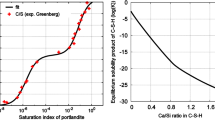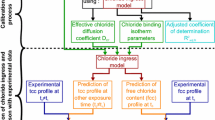Abstract
Corrosion of steel bars due to chloride ions in seawater migration into reinforced concrete (RC) lining is a major factor affecting the lifetime of subsea tunnels. To improve the safety assessment of existing subsea tunnels, a hydraulic–mechanical–chemical (H–M–C) coupled model is proposed. The long-term distribution of chloride ions migration process with hydrostatic pressure in the RC lining of subsea tunnels can be simulated more accurately. In the H–M–C coupled model, the volume fluid fraction and convection velocity obtained from the bidirectionally coupled hydraulic and mechanic analysis are unidirectionally considered in the analysis of convection, diffusion, and adsorption of chloride ions in the RC lining. In addition, the classic expression of the effective diffusion coefficient is modified by considering a constrictivity factor that varies nonlinearly with the microscopic pore size. Results indicate that the constrictivity factor has a certain effect on the migration of chloride ions in concrete. The service time of the RC subsea tunnel rapidly decreases as the most frequent gel/capillary pores radius increases on a non-linear curve. If the most frequent gel/capillary pores radius of the concrete is small, by appropriately increasing the thickness of the protective layer, the service time of the RC subsea tunnel can be effectively extended. Conversely, once the most frequent gel/capillary pores radius is large, the service time of the RC subsea tunnel will be greatly shortened. At this time, the increase in the thickness of the protective layer will no longer have significant protective effects. Afterward, the sensitivity analyses are carried out on four sets of parameters i.e., saturated permeability, van Genuchten parameters, initial saturation, and binding capacity parameters. The results of the sensitivity analyses suggest that the effects of the most frequent gel/capillary pores radius on the penetration process of chloride ions in the concrete lining of subsea tunnels are more sensitive to the initial saturation than the van Genuchten parameters. Furthermore, with the increase of the most frequent gel/capillary pores radius, the sensitivity of the chloride ion penetration to capillary pores radius under different chloride binding conditions is increasing.










Similar content being viewed by others
References
Berrocal CG, Lundgren K, Löfgren I (2016) Corrosion of steel bars embedded in fiber reinforced concrete under chloride attack: state of the art. Cem Concr Res 80:69–85
Chen D, Mei G, **ao L (2022b) Analysis of chloride invasion process in undersea RC circular lined tunnel based on nonlinear ADE theory: analytical solution, numerical verification and experimental prediction. Constr Build Mater 343:128140
Chen J, Min F, Wang S (2022a) Construction technology of shield tunnel crossing the middle channel section of yangtze river. Constr Technol Larg Diameter Underw Shield Tunn 251–290
Cui X, Bustin RM (2005) Volumetric strain associated with methane desorption and its impact on coalbed gas production from deep coal seams. AAPG Bull 89(9):1181–1202
Detournay E, Cheng AHD (1993) Fundamentals of poroelasticity. In: Fairhurst C (ed) Comprehensive Rock Engineering: Principles, Practice and Projects, Analysis and Design Method, vol II. Pergamon Press, Oxford, pp 113–171
Duzy P, Hager I, Choińska M, Amiri O (2023) Correlation between chloride ions’ migration and diffusion coefficients of alkali-activated concrete. In: International RILEM conference on synergizing expertise towards sustainability and robustness of CBMs and concrete structures, 1204–1216
Gargepuram S, Subash S, Moharana S (2021) Pore evaluation and distribution in cement mortar using digital image processing. Advances in Non-destructive Evaluation: Proceedings of NDE 2019, 125-131
Gaylarde CC, Ortega-Morales BO (2023) Biodeterioration and chemical corrosion of concrete in the marine environment: too complex for prediction. Microorganisms 11(10):2438
Gong F, Zhang D, Sicat E, Ueda T (2014) Empirical estimation of pore size distribution in cement, mortar, and concrete. J Mater Civ Eng 26(7):04014023
Guan J, Chen X, Zhang X (2022) Summary and prospect of research on seismic vulnerability of bridge structures under special complex site conditions. World Earthq Eng 1:127–138
Guo J, Yang W, Xu C, Peng B, Lin J, Qian Y (2021) Performance degradation of subsea shield tunnel segment accounting for concrete strength loss and steel bar corrosion. Shock Vib 2021:1–17
He W, Song C, Du B (2020) Key construction technology of long metro subsea tunnel in complex site conditions. Tunnels and underground cities. Engineering and innovation meet archaeology, architecture and art: Vol 7, Long And Deep Tunnels 3814
Hsieh CM (2015) Durability design of concrete structures. organizing committee of construction technology and management. (eds.) Proceedings of the August 2015 academic conference on construction technology and management 9–11
James A, Bazarchi E, Chiniforush AA, Aghdam PP, Hosseini MR, Akbarnezhad A, Martek I, Ghodoosi F (2019) Rebar corrosion detection, protection, and rehabilitation of reinforced concrete structures in coastal environments: a review. Constr Build Mater 224:1026–1039
Liu J, Liu J, Huang Z, Zhu J, Liu W, Zhang W (2020) Effect of fly ash as cement replacement on chloride diffusion, chloride binding capacity, and micro-properties of concrete in a water soaking environment. Appl Sci 10(18):6271
Liu QF, Cai Y (2022) Numerical investigation on aggregate settlement and its effect on the durability of hardened concrete. 7th International conference on the durability of concrete structures 1–7
Millington RJ, Quirk JP (1959) Permeability of porous solids. Nature 183:387–388
Mualem Y (1976) A new model for predicting the hydraulic conductivity of unsaturated porous media. Water Resour Res 12(3):513–522
Nakarai K, Ishida T, Maekawa K (2006) Modeling of calcium leaching from cement hydrates coupled with micro-pore formation. J Adv Concr Technol 4(3):395–407
Nguyen PT, Bastidas-Arteaga E, Amiri O, Soueidy C (2017) An efficient chloride ingress model for long term lifetime assessment of reinforced concrete structures under realistic climate and exposure conditions. Int J Concr Struct Mater 11(2):199–213
Niu F, Cai Y, Liao H, Li J, Tang K, Wang Q, Wang Z, Liu D, Liu T, Liu C, Yang T (2022) Unfavorable geology and mitigation measures for water inrush hazard during subsea tunnel construction: a global review. Water 14(10):1592
Pang X, Li L, Gui Q, Li K (2015) Thermohydro-ionic transport in walls of sea immerged tube tunnel. J Chin Ceram Soc 43(2):144–151
Poyet S, Charles S, Honoré N, L’Hostis V (2011) Assessment of the unsaturated water transport properties of an old concrete: determination of the pore-interaction factor. Cem Concr Res 41(10):1015–1023
Qu LQ, ** ZQ, Zhao TJ, Li QY (2007) Design study on durability parameters of reinforced concrete in submarine tunnels based on chloride salt corrosion. J Rock Mech Eng 11:2333–2340
Richards LA (1931) Capillary conduction of liquids through porous mediums. Physics 1(5):318–333
Song CY, Zhou SM (2012) The overall design of Qingdao Jiaozhou Bay subsea tunnel. Adv Mater Res 368:2971–2976
Szweda Z, Kuziak J, Sozańska-Jędrasik L, Czachura D (2023) Analysis of the effect of protective properties of concretes with similar composition on the corrosion rate of reinforcing steel induced by chloride ions. Materials 16(10):3889
Tang L, Nilsson L (1993) Chloride binding capacity and binding isotherms of OPC pastes and mortars. Cem Concr Res 23(2):247–253
Thomas MDA, Hooton RD, Scott A, Zibara H (2012) The effect of supplementary cementitious materials on chloride binding in hardened cement paste. Cem Concr Res 42(1):1–7
van Genuchten MT (1980) Closed-form equation for predicting the hydraulic conductivity of unsaturated soils. Soil Sci Soc Am J 44(5):892–898
Wang T, Dai JG, Yang LH, Wu P (2017) Chloride ion electric field migration modeling of silane water-repellent treated concrete. J Civ Eng 1:20–27
Wang J, Dong S, Dai P, Zhou C, Han B (2022) Pore structure characteristics of concrete composites with surface-modified carbon nanotubes. Cement Concr Compos 128:104453
Xue W, Liu X, **g W, Yao Z, Gao C, Li H (2020) Experimental study and mechanism analysis of permeability sensitivity of mechanically damaged concrete to confining pressure. Cem Concr Res 134:106073
Xue W, Liu W, Gao C, Fan H, Zhang H (2022) Experimental study of permeability evolution in modified desulfurization gypsum under complete stress–strain process. J Clean Prod 359:132185
Xue W, Twenda C, Alam MS, Xu L, Wang Z (2023) Experimental study on seepage characteristics and stress sensitivity of desulfurization gypsum based concrete under triaxial stress. J Market Res 24:6425–6437
Yeh HL (2013) Research on the depth of influence of concrete cracks on chloride ion transport and moisture. Master’s thesis. Zhejiang University, 81–89
Zhang CP, Li LM, Song HR, Zhang DL (2012) Safety accident analysis and risk control in subsea tunneling. Adv Mater Res 346:69–74
Zhang Y, Li X, Yu G (2016) Chloride transport in subsea concrete tunnel. Adv Mater Sci Eng 2016:1085934
Zhang YF, Yokota H, Zhu YL (2019a) Sensitivity analyses on chloride ion penetration into subsea tunnel concrete. J Adv Concr Technol 17(10):592–602
Zhang SL, Zhang WJ, Liu J, Gao J, Xu SL, Li SC (2019b) Progress in the study of concrete durability under chloride salt erosion and multifactorial coupling. China Build Mater Sci Technol 6:39–42
Zhao Y, Lin H, Wu K, ** W (2013) Bond behaviour of normal/recycled concrete and corroded steel bars. Constr Build Mater 48:348–359
Zheng SQ, Chen YQ, Liu RG, Wang JY (2023) Probabilistic analysis of durability life of concrete structures in marine environment. Ind Build 5:165–173
Zhou Y, Rajapakse RK, Graham J (1998) Coupled consolidation of a porous medium with a cylindrical or a spherical cavity. Int J Numer Anal Meth Geomech 22(6):449–475
Zimmerman RW, Somerton WH, King MS (1986) Compressibility of porous rocks. J Geophys Res, Solid Earth 91(B12):12765–12777
Acknowledgements
This study is financially supported by the Youth Research Project, Open University of China (Q22A0013), and the Open Research Fund of Key Laboratory of Bei**g University of Technology (2022B02).
Author information
Authors and Affiliations
Contributions
Yafen Zhang: conceptualization, methodology, software, validation, formal analysis, investigation, data curation, writing—original draft, writing—review & editing, funding acquisition; Ruonan Liu: validation, investigation, resources, data curation; Ruicheng Zhang: validation, investigation, data curation; Yulong Zhu: conceptualization, methodology, writing—original draft, writing—review & editing, project administration, funding acquisition.
Corresponding author
Ethics declarations
Conflict of interest
The authors declare no competing interests.
Rights and permissions
Springer Nature or its licensor (e.g. a society or other partner) holds exclusive rights to this article under a publishing agreement with the author(s) or other rightsholder(s); author self-archiving of the accepted manuscript version of this article is solely governed by the terms of such publishing agreement and applicable law.
About this article
Cite this article
Zhang, Y., Liu, R., Zhang, R. et al. Effect of Constrictivity of Gel/Capillary Pores in Concrete on Chloride Ions Migration. Iran J Sci Technol Trans Civ Eng (2024). https://doi.org/10.1007/s40996-024-01403-y
Received:
Accepted:
Published:
DOI: https://doi.org/10.1007/s40996-024-01403-y




